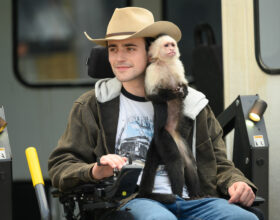“War for the Planet of the Apes” is, interestingly enough, a movie about being humane. And it is mostly the apes that are humane, with the exception of a mute girl who is very compassionate. When the apes kill her father for attempting to fire on them, an orangutan has mercy on the orphaned girl and brings her along. She turns out to be a very sympathetic girl. In fact, in one very moving scene, an ape who had given her a flower for her hair is shot and is dying. She cries as she kneels beside him and places the flower on his head. Caesar (voiced by Andy Serkis) is moved, as is the dying ape.
There’s no question that the war between the apes and humans play a big part in the movie. There are a lot of shootings, explosions, and apes strung up. And we see several scenes of blood on both humans and apes. There is the use of some strong language as well. It is the humanity that is shown that sets this movie apart. It is very well directed and features several of the humane moments already mentioned. One chimpanzee, without hair due to a virus that affected many of the apes and humans, provides comic relief such as when he shows up in a stylish winter coat, ready for a cold trip. He shows compassion by giving the mute girl a metal plate from an old car that she likes, a Chevy Nova, and Nova becomes her name. This film pays tribute to the old films by featuring Nova’s name, an original character, in addition to an orangutan named Maurice—a nod to actor Maurice Evans who voiced the character of Dr. Zaius in the original films. In another scene Nova, showing compassion on a physically-beaten Caesar, offers him water for his thirst and food for his hunger.
Viewers of this movie will no doubt be cheering the apes on, especially after a corporal played by Woody Harrelson turns out to be a real nasty character. This movie features waterfalls, woods, snow and winter scenes—very scenic for a film about war. It focuses on celebrating being different. It is well written, acted, and, maybe surprisingly, very moving at times.





